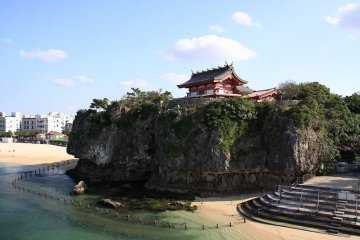
Kokusai-dori Street
Kokusai-dori is Naha’s most famous street, stretching 1.6 kilometers through the city center and offering an around-the-clock experience of Okinawan culture. Once a quiet track before World War II, the street developed rapidly after the Ernie Pyle International Theater opened to serve U.S. servicemen. Today it is a bustling thoroughfare lined with shops, eateries, arcades, and entertainment venues. The street balances international convenience with strong local character. Global brands and chain stores stand beside family-run shops, food stalls, and covered markets. Heiwa-dori Arcade, located midway along, features narrow lanes filled with pottery, seafood, textiles, and shisa statues. These lion-dog guardians, placed in pairs, are symbols of protection and good fortune throughout Okinawa. Nearby Ichiba-hondori leads to a farmers’ market showcasing fresh produce, while Mutsumi-dori provides another glimpse into the city’s traditional shopping culture. Dining and nightlife are central to the Kokusai-dori experience. Visitors can sample Okinawan specialties at izakaya and restaurants, with awamori, a rice-based distilled spirit, frequently on the menu. Stronger varieties reach up to 60% alcohol content, while habushu—awamori infused with a preserved habu viper—offers a distinctive local specialty. Evenings are the most vibrant time to visit. Street performers gather on Saturdays, providing traditional music, folk dance, and contemporary acts. On Sundays the street is closed to vehicles, transforming into a pedestrian-friendly space filled with activity. Shops typically remain open until 11 p.m., and the nightlife in surrounding bars and venues continues into the early morning hours. Easily accessible from Naha Airport by monorail, Kokusai-dori serves as both a cultural introduction and a lively gathering place. With shopping, entertainment, and food available at nearly every hour, it remains the centerpiece of Naha’s urban life.







/127.7195208,26.2170135,9/397x132?access_token=pk.eyJ1IjoiamFwYW50cmF2ZWxtYXBzIiwiYSI6ImNqbXBtOXYxbDB5Z3ozbHFrazJuYWMwOGYifQ.v15fy_mcFWtgopmz8PhwqA)
